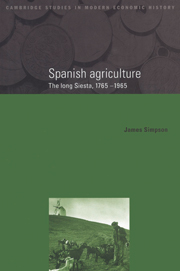Book contents
- Frontmatter
- Contents
- List of illustrations
- List of tables
- Acknowledgements
- Note on the regional division of Spain
- Abbreviations and conventions
- Introduction
- Part I The relative backwardness of Spanish agriculture
- Part II Traditional technologies and market opportunities, 1765–1880
- Part III The limits to technical change, 1880–1936
- Part IV Markets and institutions, 1880–1936
- Part V The State and the end of traditional agriculture
- Conclusion
- Appendix Estimates of agricultural output and consumption in nineteenth-century Spain
- Bibliography
- Index
Appendix - Estimates of agricultural output and consumption in nineteenth-century Spain
Published online by Cambridge University Press: 04 December 2009
- Frontmatter
- Contents
- List of illustrations
- List of tables
- Acknowledgements
- Note on the regional division of Spain
- Abbreviations and conventions
- Introduction
- Part I The relative backwardness of Spanish agriculture
- Part II Traditional technologies and market opportunities, 1765–1880
- Part III The limits to technical change, 1880–1936
- Part IV Markets and institutions, 1880–1936
- Part V The State and the end of traditional agriculture
- Conclusion
- Appendix Estimates of agricultural output and consumption in nineteenth-century Spain
- Bibliography
- Index
Summary
Historians of the nineteenth century face serious statistical problems in measuring Spanish agricultural output and productivity. The Censo de Frutos y Manufacturas of 1799, which is the most famous of the several attempts by the Spanish government between 1787 and 1803 to measure national agricultural output failed, partly on account of the frequent inertia of local representatives of the Crown, and partly because of their inability to determine accurately the cultivated area. Josep Fontana has demonstrated the weakness of the Censo de Frutos as a historical source, both on account of its production estimates and for the prices used. The unpublished figures of the Junta General de Estadística (hereafter JGE) for 1857 and 1859, and their ‘correction’ by Fermín Caballero, illustrate that relatively little had improved by the mid-nineteenth century. The JGE lamented their inability to obtain reliable information from local authorities and regarded their own estimates as far too low. Caballero's correction appears to have been a doubling of the quantities for most products, although for wheat he chose to increase it by 376 per cent!
The creation of the Junta Consultiva Inspectora in 1883 (later to be the Junta Consultiva Agronómica — hereafter JCA) brought about renewed interest in the preparation of annual harvest estimates, although the newspaper Norte de Castilla had started publishing them for wheat in 1882.
- Type
- Chapter
- Information
- Spanish AgricultureThe Long Siesta, 1765–1965, pp. 280 - 287Publisher: Cambridge University PressPrint publication year: 1996



